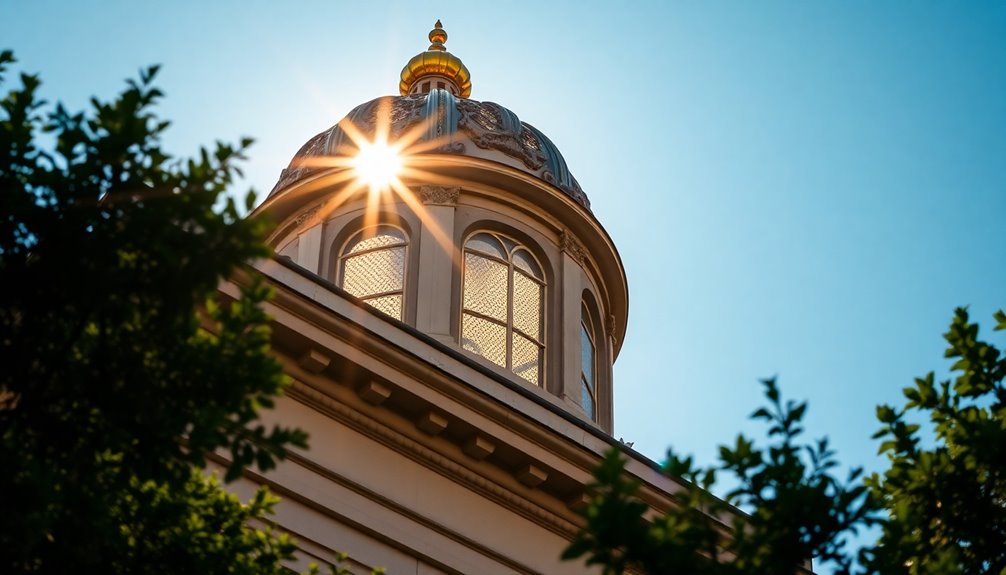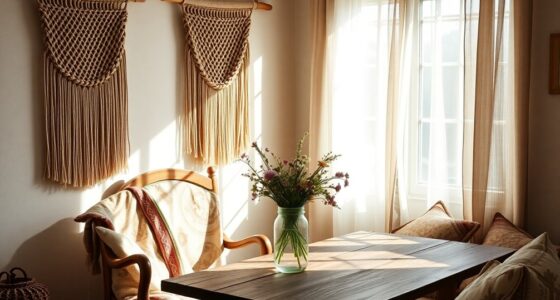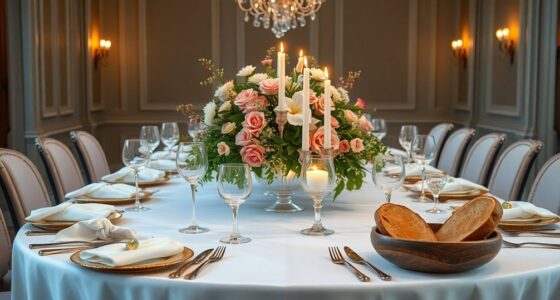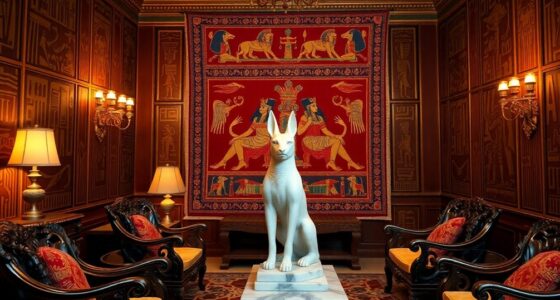Buildings have cupolas for both functional and aesthetic reasons. You'll find they enhance ventilation by allowing hot air to escape while bringing in cooler breezes, improving indoor comfort. They also let in natural light, brightening spaces and reducing energy consumption. Aesthetically, cupolas act as striking focal points, adding character and boosting curb appeal. Their unique designs can transform plain rooftops into memorable silhouettes that embody artistic expression. If you want to explore how cupolas reflect historical significance and contemporary uses, there's plenty more to uncover.
Key Takeaways
- Cupolas enhance ventilation by allowing hot air to escape while drawing in cooler air, improving indoor comfort and air quality.
- They provide natural light, reducing the need for artificial lighting and contributing to energy savings.
- Their diverse shapes and decorative elements create visual interest, enhancing the aesthetic appeal of buildings.
- Cupolas serve as architectural focal points, boosting curb appeal and property value through distinctive design.
- They symbolize cultural identity and craftsmanship, reflecting historical significance and community unity in architecture.
Historical Overview of Cupolas

Although cupolas have evolved significantly over the centuries, their origins trace back to the early 8th century in Islamic architecture, where they first adorned mosques. These structures initially crowned minarets, featuring balconies for announcing the daily call to prayer.
From there, the concept spread to Europe, becoming symbols of artistic expression. The Moors introduced cupolas to Spain, while they found a home in Russia and Italy, gaining the name 'cupola,' meaning little tub. The introduction of natural light and ventilation through cupolas also contributed to their popularity in various architectural forms.
This architectural style led to the iconic onion domes, particularly in St. Petersburg. By the post-Revolutionary Federalist Era, cupolas became prominent in American architecture, exemplified by the Capitol Building, showcasing their lasting influence across cultures and time.
Functional Benefits of Cupolas

Cupolas aren't just decorative elements; they offer significant functional benefits that enhance both the comfort and efficiency of buildings.
They improve air circulation by allowing hot air to escape and cooler air to enter, reducing moisture buildup and preventing mold growth. Their strategic placement ensures fresh airflow in areas prone to heat, like kitchens or crowded offices. Additionally, cupolas can act as a natural air conditioning unit, further enhancing indoor comfort.
Cupolas also provide natural light, brightening indoor spaces and reducing reliance on artificial lighting, which saves energy.
Plus, their elegant design draws the eye upward, enhancing a building's architectural appeal.
With various shapes and materials, cupolas add character and curb appeal, making your building stand out while boosting its overall value.
Ventilation Through Cupolas

When you think about effective ventilation solutions, cupolas stand out for their ability to enhance airflow in various types of buildings. They allow hot, stagnant air to escape, which cools the interior and boosts comfort.
As fresh air enters through lower openings like doors and windows, it creates continuous circulation, making cupolas a cost-effective, natural ventilation option. This is especially useful in stuffy areas, such as barns or workshops, where heat buildup is common.
They also help reduce moisture, preventing mold and mildew. In agricultural settings, cupolas eliminate ammonia and other unpleasant odors, improving air quality. Moreover, their customizable designs allow for matching specific architectural needs, enhancing the overall aesthetic of the building.
With their weatherproof design, cupolas ensure ventilation without compromising the structural integrity of your building.
Natural Light and Cupolas

Natural light plays a crucial role in creating inviting and energizing spaces, and cupolas are an excellent way to harness it. By incorporating windows or louvers, cupolas allow sunlight to flood your interior, brightening even the darkest corners. These structures filter sunlight, providing a softer illumination that reduces reliance on artificial lighting during the day. Unlike traditional skylights, cupolas enhance ventilation while adding visual flair to your home. They improve air quality by pulling out hot air and introducing fresh breezes, keeping your spaces comfortable. With customizable designs, cupolas can blend seamlessly with your architecture, offering both aesthetic appeal and energy savings. Additionally, cupolas can be equipped with solar lights to ensure continuous illumination while promoting sustainability. Embracing natural light through cupolas truly transforms your living environment.
Lookout Positions of Cupolas

Though often considered decorative elements, cupolas play a vital role in lookout positions, enhancing both functionality and aesthetics. These structures integrate seamlessly into roofs, providing additional support while serving as observation platforms.
By elevating your vantage point, cupolas allow for better visibility, crucial in applications like fire lookout towers. They're not just for looks; cupolas also improve air circulation and ventilation, helping to maintain a comfortable indoor climate.
With their ability to facilitate natural light and cross-ventilation, they help mitigate odors and moisture buildup. Furthermore, the historical significance of cupolas adds depth to their functional role, making them a valuable architectural feature in various buildings. Additionally, cupolas can be customized with different materials and finishes to enhance both durability and design.
Embrace the dual purpose they provide—practicality and beauty wrapped in one.
Aesthetic Value of Cupolas

The aesthetic value of cupolas is undeniable, as they transform ordinary roofs into captivating focal points. They draw the eye upward, creating a vertical accent that enhances the building's grandeur.
With various shapes like square, round, and domed, cupolas add unique visual interest. Decorative elements, such as finials and weathervanes, further embellish their charm, creating striking silhouettes against the sky. Their ability to improve air circulation also contributes to a more pleasant indoor environment, enhancing the overall living experience.
By distinguishing buildings, cupolas enhance curb appeal and serve as status symbols, reflecting architectural elegance. They can break up the monotony of large roofs, adding dynamism to the design.
Ultimately, cupolas contribute significantly to a building's overall aesthetic, making it more memorable and visually appealing.
Architectural Styles Featuring Cupolas

As you explore architectural styles featuring cupolas, you'll find that they play a vital role in defining a building's character and charm.
In Greek Revival and Second Empire styles, cupolas serve as focal points, often dome-shaped with side windows for ventilation, enhancing elegance and grandeur.
Classical architecture showcases cupolas with intricate details like columns and decorative moldings, adding timeless sophistication. Additionally, the historical significance of cupolas can be traced back to Islamic culture in the 8th century, further enriching their architectural importance.
Shingle-style homes use cupolas to unify complex rooflines, balancing horizontal and vertical elements while improving stability.
Neotraditional architecture, drawing inspiration from historical designs, incorporates cupolas for aesthetic appeal and practicality, offering ventilation and charm.
Each style highlights the cupola's functionality, making it a beloved architectural feature across various designs.
Decorative Elements of Cupolas

Cupolas bring a unique charm to architecture, thanks to their decorative elements that enhance both form and function.
Finials add vertical accents, elevating your building's grandeur, while traditional four-sided and octagonal shapes introduce visual interest.
Using durable materials like copper or steel, you can customize the finish to match your structure's aesthetic. Material choice impacts not just the longevity but also the maintenance of the cupola.
Intricate details, such as moldings and statuary, contribute to the overall elegance.
Consider various roof shapes, like concave or bell-shaped, to complement the main roofline.
Arched openings not only look appealing but can also serve as bird nesting spots.
With options for windows and louvers, you can create unique silhouettes that make your building memorable, transforming it into a stunning architectural statement.
Symbolism Associated With Cupolas

With their striking design and functional advantages, cupolas also carry rich symbolism that enhances their architectural presence. You'll find that these structures often represent freedom and resilience, like the iconic cupola atop the United States Capitol. In Renaissance architecture, cupolas symbolize grandeur and meticulous craftsmanship, reflecting the era's artistic values. They also embody cultural and spiritual significance, as seen in mosques where they connect heaven and earth. Moreover, cupolas serve as defining features of community unity and cultural identity, showcasing the unique traditions of various regions. Their timeless allure continues to inspire human creativity, reminding you of both historical legacy and the pursuit of beauty in architectural endeavors. The stunning cupola of St. Peter's Basilica exemplifies the blend of religion and human endeavor that defines many iconic structures.
Modern Uses of Cupolas

While many people admire cupolas for their aesthetic charm, their modern applications extend far beyond mere decoration.
You'll find cupolas playing a vital role in ventilation, allowing hot air to escape and fresh air to flow in, which enhances indoor air quality. They also help prevent moisture buildup, reducing the risk of mold. Additionally, cupolas can serve as a lookout point, providing an elevated perspective of the surrounding area.
In terms of lighting, cupolas let in natural light, brightening spaces and cutting down on energy use. Plus, they add a unique architectural statement, enhancing a building's curb appeal.
Frequently Asked Questions
How Do Cupolas Impact a Building's Energy Efficiency?
Cupolas significantly boost a building's energy efficiency.
They enhance ventilation by allowing hot air to escape, reducing humidity and preventing mold growth. This means you'll rely less on heating and cooling systems.
Cupolas also let natural light in, cutting down on electricity usage for lighting.
What Materials Are Commonly Used to Construct Cupolas?
Imagine a crown atop a building, elevating its elegance.
When you're considering cupola construction, several materials catch your eye. Vinyl offers durability and low maintenance, while wood provides a traditional charm that requires some upkeep.
Metal, like copper, ages beautifully, adding character over time. Other options, such as Azek vinyl or steel, deliver performance and style.
Each material gives you a chance to personalize your cupola, enhancing your building’s overall appeal. By selecting unique materials such as wood, metal, or glass, you can create a style that resonates with your personal taste and harmonizes with the surrounding architecture. This customized approach not only elevates the aesthetic but also adds value to your property, making it more inviting and distinctive. Just like France’s most famous exports, which blend tradition and innovation, your cupola can serve as a signature element that reflects a timeless elegance in design.
Can Cupolas Be Added to Existing Buildings?
Yes, you can add cupolas to existing buildings! Start by measuring and marking the roof's center. Make sure the structure can support the cupola's weight, then choose a style that fits your building's architecture.
Install mounting boards, attach the cupola securely, and seal all seams to keep water out. Don't forget to consider ventilation and lighting options to enhance functionality and aesthetics.
Regular maintenance will keep it looking great and working well!
How Do Climate Conditions Affect Cupola Design?
Climate conditions significantly affect cupola design. You need to consider factors like ventilation, moisture control, and natural light.
For instance, if you live in a warmer climate, a cupola should enhance airflow, allowing hot air to escape. You'll want to choose materials that withstand local weather, ensuring durability.
Additionally, placing windows strategically can maximize light while maintaining energy efficiency. Adapting your cupola to regional elements will improve its functionality and longevity.
Are There Maintenance Requirements for Cupolas?
If you've ever seen a charming cupola atop a historic barn, you know they need care. To maintain cupolas, you should conduct regular inspections for rust and debris, clean them annually, and check ventilation.
For instance, if you notice damaged louvers, address them promptly to avoid further issues. Keeping records of maintenance helps ensure compliance with local regulations and promotes safety during upkeep, making your cupola both functional and visually appealing.
Conclusion
In celebrating the charm of cupolas, you can truly appreciate their blend of beauty and practicality. These captivating crowns not only enhance a building's silhouette but also serve essential roles in ventilation and light. As you admire these architectural jewels, remember their rich history and the symbolism they carry, connecting past and present. Cupolas create captivating connections, crafting character and charisma in our communities, reminding us that functionality and flair can harmoniously coexist in our structures.









